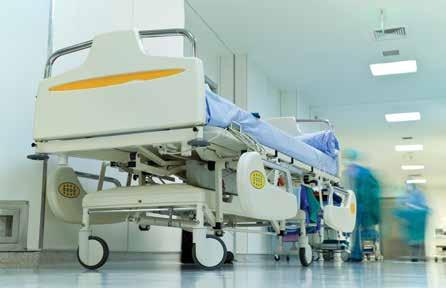
10 minute read
FROM THE PUBLISHER
VICTORIA’S STEADY ROAD TO RECOVERY
Advertisement
Victorian Premier Daniel Andrews took centre stage amid anti-lockdown protests to announce the state’s roadmap to coronavirus recovery over the weekend.
The overall plan will see restrictions eased incrementally according to health reports and the number of manageable daily COVID-19 cases.
Stage 4 restrictions will remain in place until 28 September but will start to ease once the average number of cases fall between 30-50 over a 14-day period. The latest cases are averaging at about 96 per fortnight.
In the first of these stages beginning 13 September, public outdoor gatherings in metropolitan Melbourne will increase to two people or a household, while the daily exercise limit will double to two hours. The nightly curfew will start an hour later, and people living alone will be able to expand their “social bubble” by one person.
Working from home will continue, however, and hospitality businesses will continue as take-away and delivery only.
The ultimate goal of the roadmap is to reach a stage of ‘COVID-19 normal’, which will see the end of all restrictions bar social distancing, and a return to the workplace – but only after a 28-day streak no new cases in the state.
“I want a Christmas that is as close to normal as possible,” Premier Andrews said.
“These steps are the only way.”
The roadmap has been described as a “document of despair” for industry by national employer association Ai Group.
“Rather than providing the hope and optimism required, along with clear and measurable steps for businesses to open up, [the] announcement will only prolong the economic and social pain that all Victorians are feeling,” says Ai Group chief executive Innes Willox.
“We participated in consultations on the plan in good faith, but it is clear the Victorian Government has chosen to ignore practical advice about how to now safely reopen workplaces and get the economy moving.”
Certain sectors of the industry have taken the middle lane.
“There is no playbook for responding to this crisis,” says NAB CEO Ross McEwan.
“Governments need to be flexible and act on the latest health advice and their continued support of businesses and households is vital,” he says.
“We need to get Victoria, and in particular Melbourne, open for business as quickly as possible, but we need to do it safely and cautiously.”
The science behind the Victorian roadmap is partly based on 1,000 simulations of a virtual Melbourne using epidemiological models.
Researchers observed the potential effects of lifting restrictions at varying levels based on human behaviour as it currently is in Victoria.
It showed that if restrictions are eased when daily cases dip below 25, there’s a 62 per cent chance of a need to have another lockdown to contain the virus, as opening up too soon could lead to a third wave of COVID-19.
A slow and steady approach is seen to be the best option for Victoria, but as Willox warns, it may not be enough for some.
“Significant businesses have already made decisions to divert investment away from the state and [the COVID-19 roadmap announcement] will only step up the pace of movement away from Victoria.”
As Industry Update goes to print, a deal between an Australian and a UK company for two COVID-19 vaccines is in the pipeline.
About 84 million free doses of the vaccine are planned to be rolled out across Australia in 2021 following clinical trials. - Space Saving, Lightweight, Robust Design, Fold Up Toe
Plate/Handle - Steel Frame With Durable Powdercoat Finish - Stainless Steel Version For Wash Down Applications

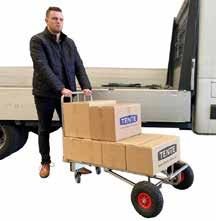
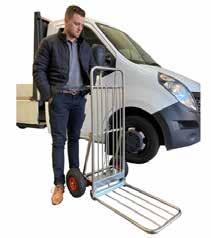


Contact Tente Castors & Wheels To Find Your Product Solution Phone: 1300 836 831 sales.au@tente.com tente.com.au
COMMON SENSE PREVAILS AS HIGH COURT OVERTURNS LEAVE DECISION
The High Court has overturned a controversial decision by the Federal Court surrounding how personal or carer’s leave is calculated under Australia’s workplace laws.
According to the Fair Work Act, employees are entitled to 10 days of paid personal/carer’s leave. For full-time employees working 38 hours a week, that’s 76 hours of leave per year.
In the case of Mondelez v AMWU, the Federal Court interpreted that entitlement as 10 days at the number of hours an employee would normally work within a 24-hour period – the “working day” construction.
This interpretation led to the Federal Court’s finding that two Cadbury chocolate factory workers were entitled to 120 hours of personal leave in a year.
The NSW Government has entered discussions with CSIRO to relocate up to 450 employees and researchers of the national science agency into a state-ofthe-art research hub in the heart of the new Western Sydney Aerotropolis.
The proposed move would see the creation of a bespoke carbon-neutral facility featuring collaborative workshops and modern, flexible laboratories to support the delivery of cutting-edge science and technology from 2026.
The facility’s new home would be the Aerotropolis Advanced Manufacturing and Research Precinct, which will
Mondelez appealed the Federal Court’s decision, and 12 months later, the High Court has now dismissed that interpretation and reverted to the common understanding of entitlement calculations.
AMMA chief executive Steve Knott says the decision isn’t just a win for Mondelez, but for employers across Australia.
“The High Court has confirmed [the Federal Court’s] interpretation was wrong,” he says.
“It states the ‘working day’ construction ‘would give rise to absurd results and inequitable outcomes’ – employers could not have said it better themselves.”
The concern with the Federal Court’s ‘working day’ interpretation was bring together research institutes and commercial organisations across advanced manufacturing, quantum technologies, aerospace, defence and agribusiness.
NSW Premier Gladys Berejiklian says Aerotropolis will be a new focal point for Australian innovation, research and productivity, making it the perfect home for Australia’s national science agency.
“CSIRO is a national icon and would set the tone for the Aerotropolis as an innovation hub, which will drive the creation of more than 200,000 jobs across the Western Parkland City,” she says. that it would lead to disparity between employees on varying shifts and rosters, particularly in manufacturing plants or mines.
“It might, for example, have seen some employees receive 120 hours of leave entitlement and others receive 76 hours, despite working the same number of hours across a two-week period,” Knott says.
“This issue has only come about due to the poor drafting of the Fair Work Act. At the time everyone knew ’10 days’ meant ordinary hours spread across two working weeks, but the legislation failed to properly clarify this.”
Knott says the High Court’s decision would be much welcomed by employers in both the resources industry and across the broader economy, which has “dodged a significant bullet” at the right time.
CSIRO chief executive Dr Larry Marshall says the agency’s presence at Aerotropolis would support collaboration and put science and technology right at the heart of the smart city.
“The more we can put science in the hands of real problems, the better our future will be, so the collaboration and connectedness of the Western Sydney Aerotropolis is an immense opportunity for CSIRO and the future we are shaping for Australia,” Dr Marshall says.
“Aerotropolis reflects the new generation of CSIRO, agile and diverse, while building on a great 100-year legacy

“A significant amount of businesses would have been exposed to huge liabilities if the Federal Court’s interpretation stood,” he says.
“It goes without saying that imposing billions of dollars of unforeseen employment costs, brought about by novel interpretations of our workplace laws, is the last thing Australian businesses need as they struggle to keep their heads above water during a global health and
CSIRO FINDS NEW HOME AT AEROTROPOLIS

economic crisis.” of innovation through collaboration. Sydney is where CSIRO invented fast WiFi and where we will invent the next innovations for our future prosperity and sustainability.”
The Aerotropolis relocation would progress CSIRO’s long-standing plans to consolidate activities and refresh its research facilities.
At the same time, the move would support the agency’s growing commitment to Western Sydney, which includes the establishment of the first CSIRO Urban Living Lab at the Sydney Science Park, a $25 million NSW Government partnership to support science, technology, engineering and maths (STEM) education, and a new 10-year lease agreement in the $350 million ‘Innovation Quarter’ precinct that will co-locate a team of CSIRO digital health and nutrition researchers at Westmead.
With an estimated completion date of 2026, the Aerotropolis aims to be one of Australia’s most connected cities supporting current and future residents, businesses and researchers.
The new CSIRO facility would also benefit from the $11 billion Sydney Metro – Western Sydney Airport rail which will service the greater Western Sydney area, and the opening of the Western Sydney International (Nancy-Bird Walton) Airport in 2026.
INFRASTRUCTURE COLLAB TO BOOST RAIL SAFETY
The Federal Government has awarded $1.5 million to a University of Wollongong research project to increase safety and use of heavy-haul and high-speed rail infrastructure.
The funding, supplied by the Cooperative Research Centres Projects (CRC-P) grants scheme, will be used to support two researchers for two years as well as a PhD scholarship.
The project, High Output, Low Cost Automated Embedded Rail Track (ERT), focuses on the development of automated solutions to reduce installation time and cost or ERT. A relatively new slab-track technology, ERT consists of a continuously laid bed of concrete with the rails embedded in the concrete in a unique way.
Where ballast track has nearly 100 individual parts per metre – requiring regular inspection and maintenance – ERT uses only four components per metre, reducing maintenance costs and maintenance-related track closures.
While it offers a number of safety and usage improvements, the installation time and cost of current ERT are significantly higher than those for ballast track – issues this research will address.
Including cash and in-kind contributions from partner organisations, the project is valued at more than $4 million. The project is led by Downer, and UOW is the lead research organisation. Other project partners are Embedded Rail Technology (Charles Penny, inventor of the ERT system), the University of Technology Sydney, and Antoun Civil.
Project leader Dr Philip Commins says ERT has many safety benefits, such as reduced track buckling and fewer derailments, but also increased track use by up to 30 per cent.
“An ERT system provides greater safety, performance and availability, with lower maintenance and reduced whole life costs,” he says.
As Australia’s plans are well advanced for many major rail infrastructure projects, Dr Commins believes the need for improved safety in heavy haul and highspeed rail is a high priority.
“This project is a key part of the chain to provide an economic alternative to the traditional rail systems.”
Downer Infrastructure Projects executive general manager Mack Mackay welcomes the funding announcement and says Downer was looking forward to working on the project with UOW and other partners.
“The University of Wollongong has always had a close affiliation with industry,” he says.
“When Downer was seeking a technology partner the university’s automation technology and rail engineering prowess made it a natural choice.”
Dr Commins and his team from the Facility for Intelligent Fabrication (FIF)
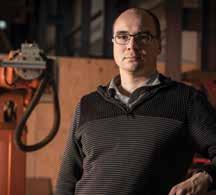
in UOW’s Faculty of Engineering and Information Sciences will focus their research on new construction techniques and will explore automation technologies to dramatically reduce the cost and improve the speed of installation to make ERT competitive with traditional ballasted track.
“UOW will focus on the automated solutions using Industry 4.0 technology such as industrial robots coupled with smart sensors and end-effectors,” Dr Commins says.
The Federal Government’s CRC-P scheme brings together researchers and industry with a focus on short-term projects that will have commercial uses.
A battery-powered chain hoist gives you portable safety onsite or offsite

250kg or 500kg CAPACI TY U SE AN YWH ERE, EVEN WI TH OU T POWER EASY TO U SE - SI M PLE TO BE SAFE
Ideal to move among equipment onsite, take from site to site or use where there is no power.


Use with an Altrac low-headroom gantry to maximise limited space such as inside a shipping container.
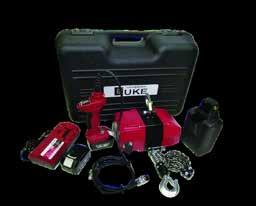
Every hoist comes with 2x 18V Li-ion batteries, single phase 240V charger and a portable case.
Contact us or visit our website for details
Duke Battery Hoists are available in Australia and NZ exclusively from Bomac Engineering





